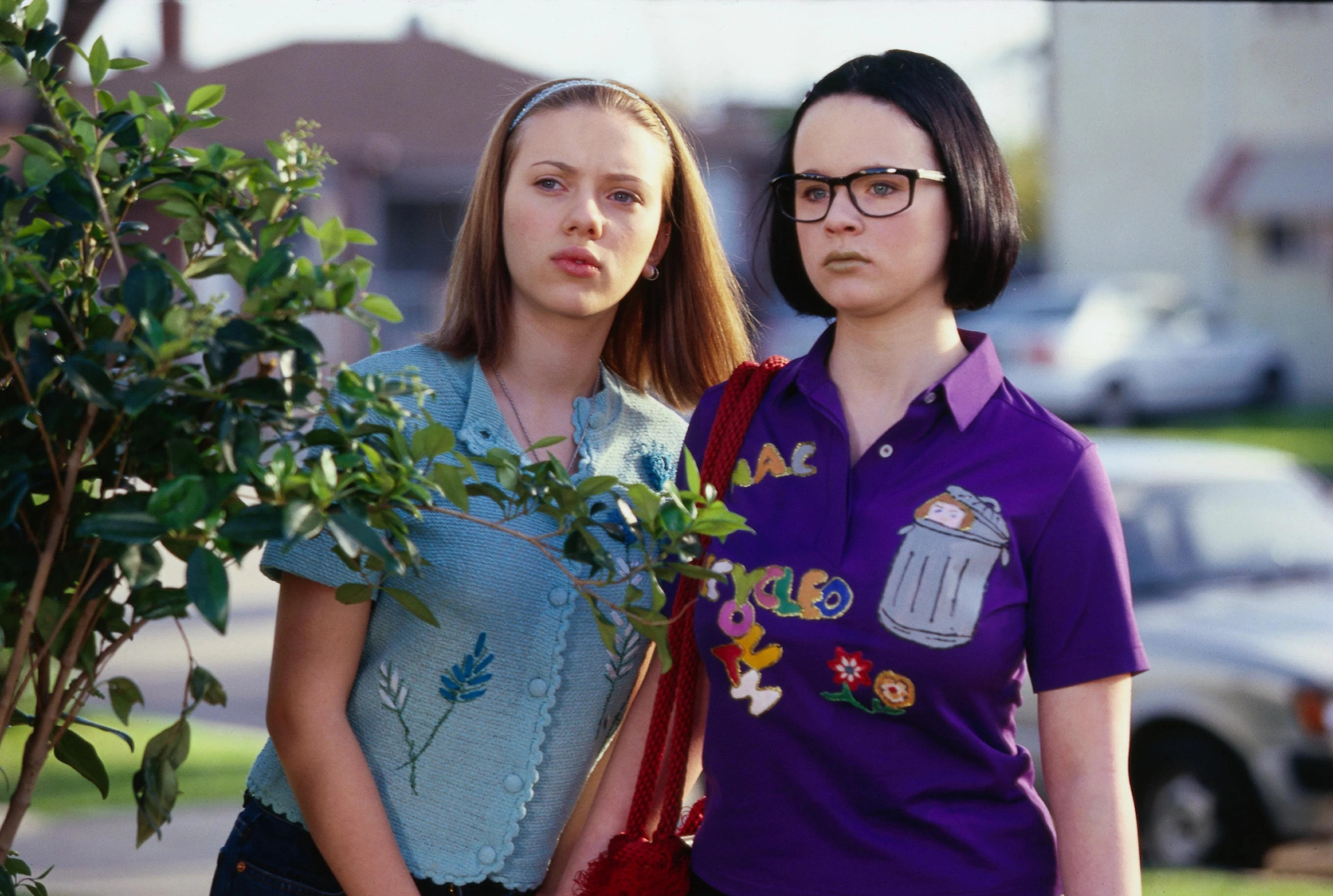Enid and Rebecca are two teenagers exploring their lives post-high school. They’re best friends, mostly because they both hate everyone else. Daniel Clowes’ Ghost World is an episodic look at their lives at this transition point, mostly through Enid’s eyes.

Does Clowes, a man who was in his 30s when writing the Ghost World comics, capture the full experience of what it was like to be a teenage girl? No, not at all, but I actually think that’s part of the point. Both Enid and Rebecca are trying on identities and letting the world shape who they want to be. Or rather, who they don’t want to be.
Clowes draws Enid and Rebecca with cartoon realism but most people who surround them carry exaggerated features. Enid, especially, doesn’t really see other people as actually having lives, but they’re just characters in hers. That’s a pretty relatable teenage attitude, regardless of its cruelty.
Rereading Ghost World this time, I was reminded that I don’t think Enid and Rebecca really like each other all that much. They’re “friends” because of history and familiarity but I don’t feel like it goes that much deeper than that. They’d be happy to let each other go, given the circumstances, as their fight about Rebecca possibly following Enid to Strathmore if she was accepted illustrates.
By the end, they have basically faded out of each other’s life, or at least that’s the implication.
I do give Clowes a lot of credit for the clothes he puts Enid and Rebecca in. They have a quirky style, but they still look like teenagers from the 1990s.
Given the episodic nature of the comics, any Ghost World movie would have to add more structure to the story. Ghost World (2001, directed by Terry Zwigoff) does this with the introduction of a new plotline — Enid has to take a remedial art class in order to graduate high school — and the expansion of one of the stories from comics — Enid and Rebecca pranking a man who placed a “missed connections” ad.
Thora Birch is essentially perfect as Enid — she’s attractive and she knows it but she also still feels like she’s in the shadow of the “prettier” Rebecca (Scarlett Johannson). She uses sarcasm as her weapon against the world that’s too often cruel toward teenage girls, but she can be as equally cruel. Birch manages to embody all these emotions — she’s clearly masking hurt and confusion but she also wants to take the world on her own terms.
Johannson does well as Rebecca, who is much more deadpan and much more of a follower here. Enid likes being in charge and the conflict between the two is when Rebecca wants something different from their lives. It’s clear what worked for them in high school no longer works for her, and Johannson plays her with the right amount of affection and weariness toward her friend.
Seymour (Steve Buscemi) feels like he’s lifted from another movie. While a few characters like him appear in the Ghost World comic, he’s mostly an invention for the movie, although they meet him because they pretended to be a woman he was seeking. Making the focus of the movie Enid’s relationship with him takes away from what should be the core relationship — Enid’s antagonistic friendship with Rebecca.
When I first saw Ghost World, I was in my early 20s so I wasn’t too far removed from high school myself (it was also long before I read the comics). I recognized myself in Enid — she was bolder and more outgoing than I was, but I understood her attitude. I liked that she was sexual but in unexpected ways. She was possibly cooler than me but it was one of the few instances where I was seeing a young woman who felt anything like me in a movie.
And I think because of that, I was willing to forgive the whole Seymour plotline. I’m a lot less inclined to do so now, though. Buscemi is sweet here, certainly, and while Seymour is kind of a world-weary sadsack, the movie is mostly kind toward him. He’s just a weird dude who likes the specific things that he likes.
I understand why Enid finds him interesting — I found him to be more interesting this time around, and funnier and kinder — but I also get tired of young women ending up in “romantic” situations with older men. As much as he didn’t really deserve to have this teenage girl come in and ruin his life, I do feel like it comes across as a bit of wish fulfillment on the part of the filmmakers.
I wonder what a Ghost World movie would’ve been had a woman written and directed the adaptation.
Illeana Douglas as Enid’s art teacher has some good moments (mostly because she’s Illeana Douglas), the criticism of art classes, the people teaching them and the students taking these classes also feel inserted from another movie. While this plotline and the one with Seymour do collide, either one could have been lost and the movie would’ve been better for it.
Whenever I brought up the concept of this project with people, the first thing they said to me was “Like Ghost World?” I don’t know if it’s the most famous non-superhero movie that most people know is based on a comic, but people absolutely know it’s based on a comic. I also blame this movie for this project.
Do I like the Ghost World movie? Yes. It’s well-made and well-acted and despite my issues with it, it’s quite a bit of cynical fun. As I get older, do I wish it was something else? Maybe a bit.

